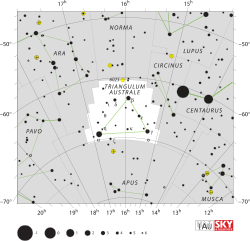Beta Trianguli Australis

| |
| Observation data Epoch J2000 Equinox J2000 | |
|---|---|
| Constellation | Triangulum Australe |
| Right ascension | 15h 55m 08.56206s[1] |
| Declination | −63° 25′ 50.6155″[1] |
| Apparent magnitude (V) | 2.85[2] |
| Characteristics | |
| Spectral type | F1 V[3] |
| U−B color index | +0.05[2] |
| B−V color index | +0.29[2] |
| Astrometry | |
| Radial velocity (Rv) | +0.4[4] km/s |
| Proper motion (μ) | RA: −188.66[1] mas/yr Dec.: −401.85[1] mas/yr |
| Parallax (π) | 80.79 ± 0.16[1] mas |
| Distance | 40.37 ± 0.08 ly (12.38 ± 0.02 pc) |
| Details | |
| Surface gravity (log g) | 4.219 ± 0.066[5] cgs |
| Temperature | 7,384 ± 368[5] K |
| Rotational velocity (v sin i) | 79[6] km/s |
| Other designations | |
Beta Trianguli Australis (β TrA, β Trianguli Australis) is a double star in the southern circumpolar constellation of Triangulum Australe. It is approximately 40.37 light-years (12.38 parsecs) from Earth and has an apparent visual magnitude of +2.85.[2] This star has a relatively high rate of proper motion across the celestial sphere.[7] It is a F-type main-sequence star with a stellar classification of F1 V.[3] Beta TrA has a 14th magnitude optical companion at an angular separation of 155 arcseconds.
Observation with the Spitzer Space Telescope reveals what appears to be an excess infrared emission from this star. This suggests the presence of circumstellar material in this system, making it a debris disk candidate.[8] This star may be a member of the Beta Pictoris moving group, an association of about 17 stars that share a common origin and a similar motion through space. If it is a member of this group, this would put the age of β TrA at about 12 million years; the same as the group itself.[9]
Modern legacy
β TrA appears on the flag of Brazil, symbolising the state of Santa Catarina.[10]
References
- ↑ 1.0 1.1 1.2 1.3 1.4 van Leeuwen, F. (November 2007), "Validation of the new Hipparcos reduction", Astronomy and Astrophysics 474 (2): 653–664, arXiv:0708.1752, Bibcode:2007A&A...474..653V, doi:10.1051/0004-6361:20078357
- ↑ 2.0 2.1 2.2 2.3 Nicolet, B. (October 1978). "Photoelectric photometric Catalogue of homogeneous measurements in the UBV System". Astronomy and Astrophysics Supplement Series 34: 1–49. Bibcode:1978A&AS...34....1N.
- ↑ 3.0 3.1 Gray, R. O. et al. (July 2006), "Contributions to the Nearby Stars (NStars) Project: spectroscopy of stars earlier than M0 within 40 pc-The Southern Sample", The Astronomical Journal 132 (1): 161–170, arXiv:astro-ph/0603770, Bibcode:2006AJ....132..161G, doi:10.1086/504637
- ↑ Evans, D. S. (June 20–24, 1966), Batten, Alan Henry; Heard, John Frederick, eds., The Revision of the General Catalogue of Radial Velocities, University of Toronto: International Astronomical Union, Bibcode:1967IAUS...30...57E
- ↑ 5.0 5.1 Allende Prieto, C. et al. (June 2004), "S4N: A spectroscopic survey of stars in the solar neighborhood. The Nearest 15 pc", Astronomy and Astrophysics 420: 183–205, arXiv:astro-ph/0403108, Bibcode:2004A&A...420..183A, doi:10.1051/0004-6361:20035801
- ↑ Bernacca, P. L.; Perinotto, M. (1970). "A catalogue of stellar rotational velocities". Contributi Osservatorio Astronomico di Padova in Asiago 239 (1). Bibcode:1970CoAsi.239....1B.
- ↑ "LTT 6339 -- High proper-motion Star", SIMBAD (Centre de Données astronomiques de Strasbourg), retrieved 2012-01-28
- ↑ Koerner, D. W. et al. (February 2010), "New Debris Disk Candidates Around 49 Nearby Stars", The Astrophysical Journal Letters 710 (1): L26–L29, Bibcode:2010ApJ...710L..26K, doi:10.1088/2041-8205/710/1/L26
- ↑ Nakajima, Tadashi; Morino, Jun-Ichi; Fukagawa, Misato (September 2010), "Potential Members of Stellar Kinematical Groups within 20 pc of the Sun", The Astronomical Journal 140 (3): 713–722, Bibcode:2010AJ....140..713N, doi:10.1088/0004-6256/140/3/713
- ↑ Astronomy of the Brazilian Flag, FOTW Flags Of The World website
| ||||||||||||||||||||||||||||||||||||||||||||||||||||||||||||||||||||||
| ||||||||||||||||||||||||||